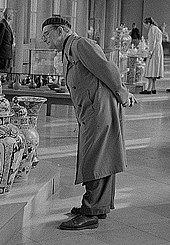Richard Peter
Richard Peter (born May 10, 1895 in Klein Jenkwitz , † October 3, 1977 in Dresden ) was a German press photographer and photojournalist . His photographs of Dresden immediately after the end of World War II , including the view from the town hall tower to the south , made him famous.
Live and act
Richard Peter was born in Klein Jenkwitz in the district of Ohlau and spent his childhood there. He worked as a blacksmith and a miner . He participated in the First World War as a soldier. After the war he lived in Halle (Saale) , where he joined the labor movement and first became a member of the USPD and in 1920 of the Communist Party of Germany . Because of his participation in uprisings in Leuna, he fled to Vienna, shortly afterwards Dresden became his new adopted home. In the 1920s he published numerous photographs that appeared in advertising magazines and monthly newspapers. Above all, however, he saw himself as a worker photographer and photographed pickets and slogans, conditions in workshops (these mainly with a hidden camera), as well as the living conditions of working-class families (including child labor in the home industry). These appeared mainly in the AIZ .
At the end of the 1920s he went to Argentina, which he left again in 1929 due to lack of economic success. In 1930 he traveled to Scandinavia for almost a year. The photo reports produced in both cases were also published.
In 1933, after the NSDAP came to power, he was banned from working as a press photographer, which was lifted again in 1939. From 1933 he smuggled recordings of the persecution of the Jews and attacks on Jewish shops and facilities to the AIZ, which was now being produced in exile in Prague.
Nevertheless, he was able to continue taking photos as an advertising photographer for various companies, which were published in Dresden newspapers and magazines. In 1939/40 and from 1943 he was drafted into the Wehrmacht.

Richard Peter returned from captivity to his adopted home Dresden in September 1945 and photographed the city destroyed by the air raids on Dresden and its reconstruction. His photographs were first published in Dresden in 1950 , a camera is suing . He was the head of the KPD-Bildstelle and then editor-in-chief of the magazine Zeit im Bild as well as the regional editor of the newspaper Der Freie Bauer .
In 1949 Richard Peter was expelled from the Socialist Unity Party of Germany for “behavior that was harmful to the party” . The reason was his efforts to clear up a case of corruption involving the mayor of the municipality of Weixdorf north of Dresden .
From the mid-1950s he worked as a freelance artist for publishing houses and advertising until his death in 1977 and achieved international recognition.
Richard Peter died in Dresden and was buried in the Heidefriedhof .
Richard Peter had a son, Richard Peter jun. (1915–1978), who also became known as a photographer.
estate
His 6,500 negatives, around 2,500 positives as well as a few hundred small picture dias extensive photographic estate from the period 1945–1977 was acquired in 1983 by the Deutsche Fotothek . Peter's recordings made before 1945 have been lost due to the destruction of Dresden, with the exception of reproductions and publications.
Works
- Dresden - a camera accuses. Dresdener Verlagsgesellschaft, Dresden 1949.
- Dresden - a camera accuses. Fly Head Verlag, Halle / Saale 1995, ISBN 3-930195-03-8 .
- Memories and pictures of a Dresden photographer , autobiography, edited by Werner Wurst, Fotokinoverlag, Leipzig, 1987, ISBN 3-7311-0039-8 .
literature
- Richard Peter . In: Birgit Dalbajewa (ed.): New Objectivity in Dresden . Sandstein Verlag, Dresden 2011, ISBN 978-3-942422-57-4 , p. 330-331 .
- Anke Scharnhorst: Peter (sen.), Richard . In: Who was who in the GDR? 5th edition. Volume 2. Ch. Links, Berlin 2010, ISBN 978-3-86153-561-4 .
Web links
- Information on Richard Peter in the Deutsche Fotothek
- German Historical Museum Berlin , Richard Peter sen.
Individual evidence
- ↑ a b c d e f g Monika Dänhardt: Out and about with a hidden camera. Richard Peter became world famous for his photos of the destroyed Dresden. But he wasn't the great hero. In: Sächsische Zeitung from 30./31. May 2015, p. 17. Available online. Retrieved May 31, 2015.
- ↑ a b c d Anke Scharnhorst: Peter (sen.), Richard . In: Who was who in the GDR? 5th edition. Volume 2. Ch. Links, Berlin 2010, ISBN 978-3-86153-561-4 .
- ^ Sylvia Ziegner: The Dresden illustrated book - a camera accuses Richard Peter senior. Part of Dresden's culture of remembrance. Dissertation at the Philipps University of Marburg, Marburg 2010, pp. 34–35 ( uni-marburg.de [PDF; 18.1 MB]).
| personal data | |
|---|---|
| SURNAME | Peter, Richard |
| BRIEF DESCRIPTION | German photojournalist |
| DATE OF BIRTH | May 10, 1895 |
| PLACE OF BIRTH | Klein Jenkwitz , District of Ohlau , Province of Silesia |
| DATE OF DEATH | 3rd October 1977 |
| Place of death | Dresden |

